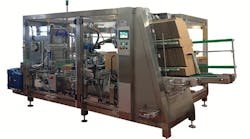Food retailers are calling for a lot from secondary packaging. And processors can heed that call by listening to their end-of-line equipment.
Demands for versatility in secondary packaging are more intense than ever. Many retailers – and not just among the rapidly growing discount sector – want cases, if not pallets, that they can put on the shelf or floor with little or no preparation. They want specialized small loads, often mixed, and many of them want their primary packages arranged in unique ways.
“I think with our customers, the biggest priority right now is for them to find a solution for the retail-ready environment,” says Peter Fox, senior vice president of sales at Somic America (www.somicamerica.com). “So basically what they’re looking for are different ways that they can effectively produce their secondary packaging, their case, so that it is easy for their end user to be able to use and display on shelf.”
Jerry Buckley, a regional sales manager for BluePrint Automation (www.blueprintautomation.com), agrees. “It really comes down to, our customers are pushing us more toward packages that are shelf-ready,” he says. “They used to just package things in an RSC [regular slotted container]. Now they want the case to be the display tray. They want versatility where it could be a single product on a shelf, and what used to be lying flat now needs to stand up vertically, or it could be double rows of products.”
Versatility in packages means versatility in machinery, especially when package configurations increase but the number of packages in each configuration goes down.
The requirements are “flexibility and scalability. What’s driving the end users is all being driven by the retailers,” says Henk Hoogendoorn, global sales manager of Hartness International (www.hartness.com). “We’re seeing a reduction in case count sizes, which means more packages per minute, because they’re going from 12- and 16-counts down to eight, which is also being driven by the dollar-type stores which have smaller shelf spaces available. We see flexibility and scalability, because people don’t know what their package format’s going to be in the future.”
Versatility encompasses more than just how many primary packages go into a case. Some retailers want packages with covers that can tear off, leaving a display-ready tray. Some even favor cases that split apart lengthwise, with the halves folding outward into parallel displays.
Somic recently introduced the Flexx III, an addition to its 424 series of end-of-line machinery that combines case erecting, filling and closing. The Flexx III can do any arrangement or orientation, and can use a robot to pick and place primary packages like pouches into a case as an alternative to forming the case around them.
Talking points
Where omnibus equipment like the Flexx III is not an option, enhanced communication can help machines perform end-of-line functions in tandem with maximum efficiency.
The Ishida unit of Heat and Control (www.heatandcontrol.com) offers a turnkey packaging system for bagged snacks like potato chips that comprises the Inspria bagmaker, the Thickness Seal Checker and the ACP-700 case packer. All of these machines can be bought and operated separately, but when used together, they allow feedback loops for continuous communication and correction.
When the seal checker, in the middle, detects a change in the thickness of the bags, meaning a change in the amount of air in the bag, it can signal upstream to the bagger to adjust the air in the fill, and downstream to the case packer to change indexing and belt speed to accommodate.
Communication is also important between equipment and operator. As machinery becomes more versatile and therefore more complicated, making the controls comprehensible becomes more of a challenge.
“We want the customer to be able to take the machine, have a fairly untrained operator change the machine over and understand what they’re doing, and get feedback if the machine is not adjusted correctly,” says Jason Enninga, vice president of sales at the Brenton Engineering unit of Pro Mach (www.brentonengineering.com).
Harpak, maker of end-of-line machinery like this wraparound case packer, recently announced a strategic partnership with Rockwell Automation to enhance its equipment’s productivity.
Brenton’s new M2000 case packer, which replaces its Mach 2, comes with both manual and fully automated options. The manual version can include programmable settings, with LED interior lights that indicate when parts are adjusted properly for a particular setting. The fully automated equipment uses servos to move all adjustable parts into position for changeovers.
The last option adds between $50,000 and $100,000 to the machine’s cost, and is mostly for the biggest customers, Enninga says: “It’s really the Fortune 500 guys that see the value of [fully automatic] changeover.” The majority of customers go for the manual option, which not only guides manual adjustment of components but helps pinpoint what went out of whack when a stoppage occurs.
Harpak-ULMA is so committed to better communication that, at the 2018 Pack Expo, it announced a strategic partnership with Rockwell Automation to enhance its production of what CEO Kevin Roach called “smart, connected” equipment. This alliance will enable better onboard diagnostics, safety technologies and generation of production data, and generally make it “easier to install, integrate, optimize and maintain any packaging line,” Roach said.
Where does it hurt?
Better maintenance is a major advantage of enhanced communication capability, because machines are literally able to tell you what’s going wrong.
“Customers now are looking for more management information so that they can sit remotely and see how their systems are doing, if they’re reliably running, if there have been any issues with downtime,” says Irwin Azriel, a regional sales manager of the Orion unit of Pro Mach (www.orionpackaging.com).
An Orion stretchwrapper can even tell its operator how efficiently it’s running. “Where the average cost may have been 30 cents a pallet and for some reason it jumped up to 60 cents, then [operators] can determine what’s going on, get a maintenance person down there and not let the machine continue to run inefficiently,” Azriel says.
When something does go wrong enough to stop a machine, enhanced communication capability can help pinpoint the problem. R.A. Jones recently introduced the Criterion CLI-100, an intermittent-motion cartoner that features “fault-zone lighting.” When the cartoner goes down, the section with the component that need fixing literally lights up in red, guiding operators or maintenance workers to the problem.
Weighing the data
The advantages of connectivity extend up the packaging line, to the equipment that makes sure enough product is in the package — but not too much. Checkweighers can be a rich, ongoing source of data that suggests a path to greater efficiency.
Checkweighers, like the CM9400 from Mettler-Toledo, are a rich potential source of statistical information.
“Product inspection devices in general are big data sources, and a checkweigher is certainly one of those,” says Tom Dorward, product manager at Mettler Toledo (www.mt.com/hi-speed). “We’re giving you the statistical data – how many rejects you had, and in the case of a checkweigher, how much you’re overfilling, so how much product are you actually giving away. That’s all data points that can come back to the customer [who can] say, I can maybe lower my fill rate and not give away product but still meet the standards.”
This data can be sliced and diced to give information on rejects, trends, pack rate and other parameters down to the batch level. Checkweighers from Loma Systems (www.loma.com) can export this data to Excel and other popular software, says Antoine Dodier, customer relationship manager.
Checkweighers also face the same operational imperatives as other equipment, such as speed and durability. Dodier says the Loma CW3 line of checkweighers now comes with an upgraded IP rating for washdown resistance. This is important to an increasing number of customers, whose attitude Dodier characterizes as, “I want a checkweigher, but I want it like a submarine.”
Another important aspect is keeping up with the rest of the line. Mettler Toledo’s CM9400 XS checkweigher features technology that eliminates the need for timing screws and integrates timing, spacing and scale sections, enabling the checkweigher to run at the same speed as the balance of the production line.
Dorward says data collection and analysis may be the newest thing to get attention, but “a lot hasn’t changed. [Customers are] really looking for security, for performance, for quality. Dependability and return on investment are definitely key things.”


